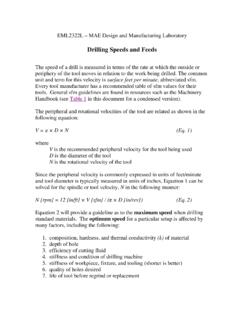Transcription of OLD SCHOOL WAY TO BUILD A HOT CHEVY ENGINE
1 OLD SCHOOL WAY TO BUILD A HOT CHEVY ENGINE Let's start off by deciding which ENGINE to BUILD . Do you want some power yet still not have to buy premium gas, or lots of power and not care about gas mileage. It is a big misconception these days that horsepower is the main concern. Not true. You can have a lot of horsepower, but without the torque to go with it you don't have much. Torque is the big thing you want. It's what sets you back in the seat when you punch the gas pedal So forget about all those ads you see about this add on gives you 10 more horsepower.
2 After you spend the money for most of those, you won't even feel the difference in performance. Most everyone that has been around CHEVY engines has heard of all the different ENGINE sizes. Whether it was 283, 302, 305, 307, 327, 350, or even small block 400. All of these can be built to run very strong. Take the 350, rebuild it with standard size bearings and rings, but install a set of 305 heads , a RV style cam or CHEVY 350/350 camshaft. You can use a stock intake manifold with a quadrajet carb and you will have some decent power. Using 305 heads is the key.
3 Yes they have those little extra holes for the water jackets but that doesn't matter, you just need to use the 350 head gaskets. The cambers are smaller so you get more compression. This is a must do if you bore the cylinders out any from standard size. Don't be afraid to mill ( or called shave) the surface of the heads either, as there is lots of valve clearance with stock pistons. Now lets go for more gusto. If you have one or can get your hands on a 327 short block great. They made two different ones. One was a small journal crankshaft and the other was a large journal.
4 If you get a small journal one save it, as that can be made into a 302. Most of the 327's I've built were bored 30 over. Of course you need pistons and oversized rings. Then you need a set of large valve heads. There still are some around with intake valves. Mill the heads 20 thousands. You need to do some port matching. All you need to do this is a dremal tool, electric will work, but air is better. Bolt a new intake gasket to the intake side of the head and use a marker or sharpe to outline the inside area of each port. Remove the gasket and using the dremal tool with a tungsten bit grind down the inside area at a slant or curve towards the valve area until the opening is the same as the gasket mark you made.
5 This will take a lot of time on cast iron heads but it can be done. You also want to do the same for the exhaust ports by bolting a header gasket on. Then you can move on to the intake. CHEVY made a mid profile aluminum intake which can be found, but not too easily. An aftermarket one may be the only choice. I personally use quadrajets, one from a 454 works nice on this ENGINE , but that is your choice. CHEVY used to sell a 327/375 horsepower camshaft but have discontinued it. There is one you can get from crane that is close enough. These were solid lifter cams, however I always ran hydraulics in the ENGINE .
6 ( Hate resetting valves all the time). Yes you can run hydraulics on a solid lifter cam but don't try the other way around. Lets say something about distributors. Back in the day( LOL!!) most of what we had were point type which were Ok, but there was a lot of point bounce at high revs, and not a high spark, till 1975 when CHEVY came out with HEI. They work great even with the stock type coil. Plenty of spark. After you put this ENGINE together and run it you will see what it means to be put back in your with power. It will have enough torque to send your car or truck down the road fast.
7 Now the ultimate small block to me is the 302. It will wind up very fast in RPM's. You can BUILD one, providing you can find parts from stock. What you will need is a 327 small journal crankshaft block. Then you need a 283 crankshaft, which were all small journal. Most of these were cast but there are some forged ones out there. A cast one will work fine depending on how often your foot gets lead in it. You need to use the 327 rods, however the pistons won't work. You could try to find some stock 302 pistons, but that's almost impossible now. The best thing is to get an aftermarket set from someone like Summit or Jeg's, that have the wristpin location higher up on the piston so that the valves will clear.
8 The last one I built had Jahns :1 pop ups in it. Had to use two head gaskets under each head. Again you want to use the 375 horse cam, but need to use solid lifters so they won't float at high RPM's. The heads should be valve ones. If you use a quadrajet carb, get one from a 454 or if you like Holleys use at least a 750 cfm. This ENGINE will shock you, especially in a small car. If you have built engines before you may have gotten the bolt torque specs from a book. And thats good, but I have always used my own specs which have never failed. The rod bolts I torque to 45 foot pounds, in three steps ( 15,30,45).
9 Main cap bolts were set at 80 foot pounds in three steps (20,50,080). The head bolts were set to 85 or 90 in three steps ( 25,55,85-90). Never had a blown head gasket or spun bearing. Last but not least, it seems everyone don't even think about the old 307. It has a bore and stroke of x , which if you use 305 heads and a mid range cam will produce a strong ENGINE . Now gather up your parts and start building an ENGINE that will not cost an arm and leg, but will surprise you at the power it has. The best place I have found to get good gsket sets and rebuild kits is from Northern Auto Prts.
10 They have a web site and ship stuff very fast. Most all the gaskets are Felpro. This is how I do heads Start by pulling the heads from your ENGINE ( Image-1), you will need to clean them. A good cleaner is Mean Green. Soak the heads down real good, then let them set for at least an hour. If you have a pressure washer or access to one, great. If not sometimes you can take them to a car wash and spray them.( IF THEY ALLOW IT) Yes it's messy, but elbow grease is cheaper than having them cleaned by a machine shop.





